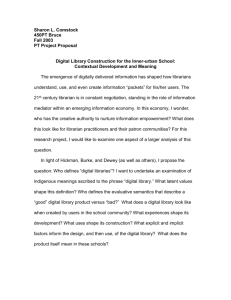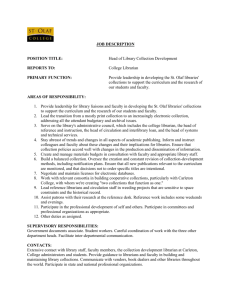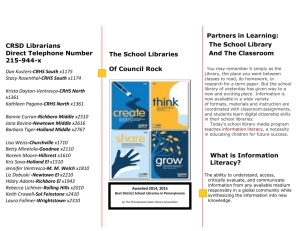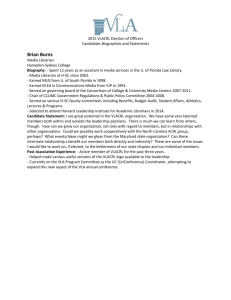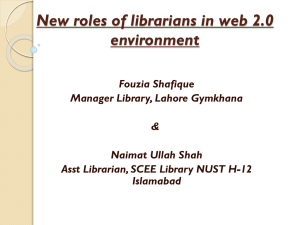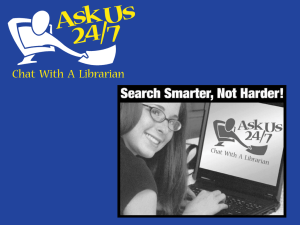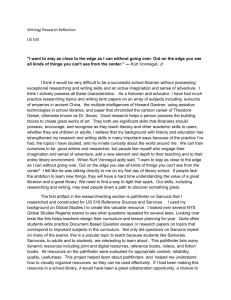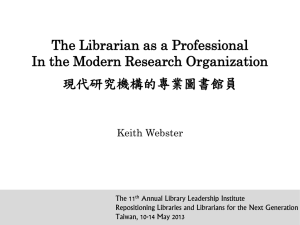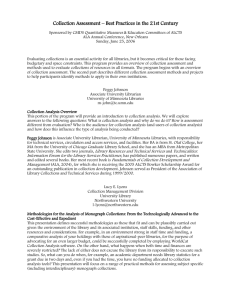E-forum report
advertisement
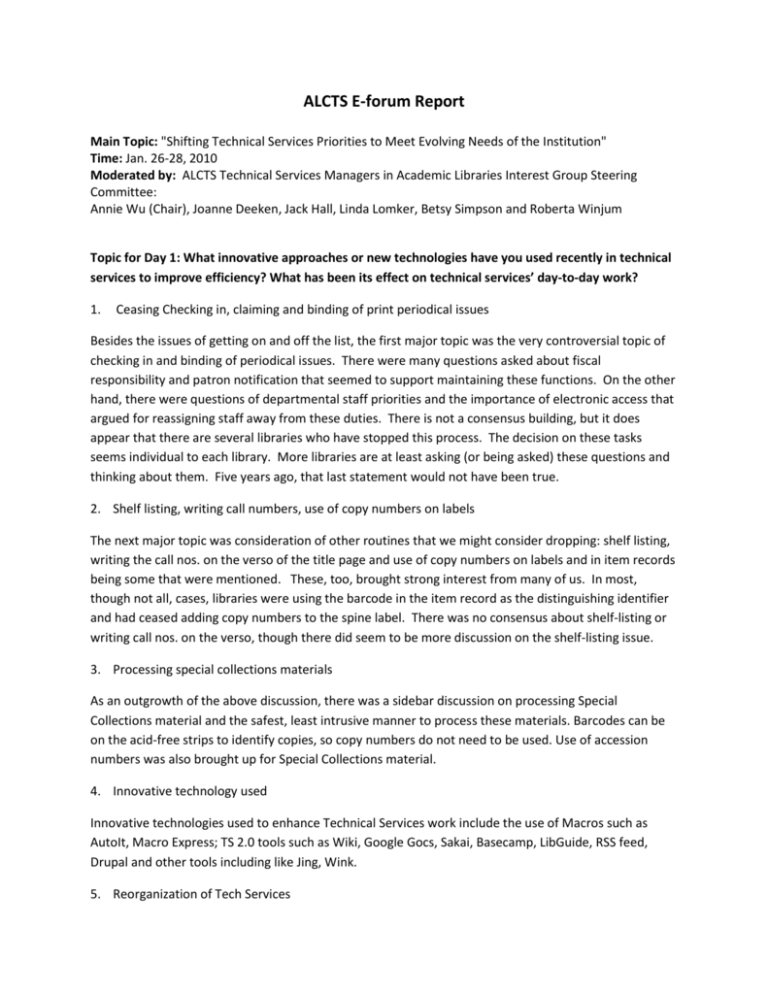
ALCTS E-forum Report Main Topic: "Shifting Technical Services Priorities to Meet Evolving Needs of the Institution" Time: Jan. 26-28, 2010 Moderated by: ALCTS Technical Services Managers in Academic Libraries Interest Group Steering Committee: Annie Wu (Chair), Joanne Deeken, Jack Hall, Linda Lomker, Betsy Simpson and Roberta Winjum Topic for Day 1: What innovative approaches or new technologies have you used recently in technical services to improve efficiency? What has been its effect on technical services’ day-to-day work? 1. Ceasing Checking in, claiming and binding of print periodical issues Besides the issues of getting on and off the list, the first major topic was the very controversial topic of checking in and binding of periodical issues. There were many questions asked about fiscal responsibility and patron notification that seemed to support maintaining these functions. On the other hand, there were questions of departmental staff priorities and the importance of electronic access that argued for reassigning staff away from these duties. There is not a consensus building, but it does appear that there are several libraries who have stopped this process. The decision on these tasks seems individual to each library. More libraries are at least asking (or being asked) these questions and thinking about them. Five years ago, that last statement would not have been true. 2. Shelf listing, writing call numbers, use of copy numbers on labels The next major topic was consideration of other routines that we might consider dropping: shelf listing, writing the call nos. on the verso of the title page and use of copy numbers on labels and in item records being some that were mentioned. These, too, brought strong interest from many of us. In most, though not all, cases, libraries were using the barcode in the item record as the distinguishing identifier and had ceased adding copy numbers to the spine label. There was no consensus about shelf-listing or writing call nos. on the verso, though there did seem to be more discussion on the shelf-listing issue. 3. Processing special collections materials As an outgrowth of the above discussion, there was a sidebar discussion on processing Special Collections material and the safest, least intrusive manner to process these materials. Barcodes can be on the acid-free strips to identify copies, so copy numbers do not need to be used. Use of accession numbers was also brought up for Special Collections material. 4. Innovative technology used Innovative technologies used to enhance Technical Services work include the use of Macros such as AutoIt, Macro Express; TS 2.0 tools such as Wiki, Google Gocs, Sakai, Basecamp, LibGuide, RSS feed, Drupal and other tools including like Jing, Wink. 5. Reorganization of Tech Services Reorganization of Tech Services from Departments (Acquisitions/Serials and Cataloging) into units (Resource Procurement; Resource Processing and Description; and, Resource Maintenance) based on tasks. 6. Use of Wiki and other mechanisms in Tech Services The last major topic dealt with the use of wikis or other mechanisms in Technical Services. Miami University of Ohio led the way with an extensive list of alternative ways to automate ranging from WIKIs to the use of macros in cataloging records. More libraries seemed interested in how to use these media than in mentioning how they were currently using them. Fresno State is using LibGuides to create and share cataloging policies. 7. Topic continued on 2nd day The first day topic discussion continued a little on the second day briefly. Specific examples included adding genre headings for fiction, adding page numbers to 504 fields, altering series tracings to match authority records, and adding 505 fields. A PromptCat user mentioned that it’s important to strike a balance in how much tweaking is done on the front end vs. fixing errors on the backend. It was pointed out that CatExpress users are restricted in their ability to edit OCLC records, and this has created a situation where they routinely make local-only revisions. But for the system to work well, a critical mass of libraries has to continue to update the master records in OCLC. A preservation librarian voiced support for having the call number written on items. It’s particularly helpful when dealing with damaged material that lacks other identifying information (e.g., barcode, spine label). Transliterated titles are sometimes written on TPs of foreign language items to allow users and staff to easily confirm they have the correct item. A law librarian described an organizational change prompted by a retirement that involved staff reassignments and downsizing in Tech Services. New workflows have to be developed. She plans to involve staff in the process and asked for suggestions. Topic for Day 2: How have you helped your staff learn and apply the new approach and technology? How have you dealt with resistance to change? The primary topic of Day 2 of the forum prompted a number of suggestions, including the following: 1. Helping staff learn and apply new approaches and technology: Offer detailed instructions, screenshots, and relevant examples Consider using various tech aids as part of training (e.g., PowerPoint, youtube, Wink and Jing for tutorials) Encourage and empower staff to help each other with questions and problems Provide one-on-one support Add an element of fun; silliness is allowed Use food to “smooth the way”, especially chocolate! (e.g., when launching a departmental PBWiki last year, Miami U had a PB launch party with “anything and everything peanut butter”) 2. Dealing with resistance to change: Communicate clearly and early about the rationale for the change Take advantage of training opportunities on effective communication Describe the benefits to be derived from implementing the change and give practical examples if possible Politely commiserate with staff when the change doesn’t seem to have many benefits (e.g., furlough) Help staff see the big picture Hear staff out and try to understand where they’re coming from Involve staff in decision-making and allow them to take a leadership role Do a trial run to test the change Keep in mind that each person learns differently and be aware of multi-cultural issues Remember to evaluate the change Try to determine the reasons behind the resistance to change (e.g., Is it a training issue? Need for encouragement?) Be prepared to take more serious steps in dealing with extreme cases; consult with your supervisor and HR staff for advice It's important each of us take on and obtain continually improved management and leadership skills Topic for Day 3: What are some of the examples of collaboration efforts of your technical services department with other departments in your library or across libraries? What are the benefits and disadvantages of the collaboration efforts? How could the library go about improving collaboration? 1. Involve librarians from other departments, branches or institutions in projects, committees, task forces. Below are posted examples: Form a Technical Services Advisory Council including librarians from various types of branches – large, medium, small, city branches, county branches. Working with this group to gather input on benefits, drawbacks, potential problems. International collaborative effort in the Biodiversity Heritage Library ( http://biodiversitylibrary.org ) project, comprised of 10+ natural history, museum, and science libraries, which is a multi-function portal of the out of copyright body of world biodiversity literature. Collection management committee made up of both user services and tech services librarians. From E-resources management from 1 person doing almost everything (purchase, licensing, set up, troubleshooting, training…) to collaborative approach involving reference services librarian, the systems librarian and serials and e-resources librarian. 2. Constant communication with librarians from other departments. Highlighted points are: Librarians communicate on a weekly and daily basis through email, conference calling, webinars, and periodic face to face meetings to develop the form and structure and day-to-day operation of this freely accessible online library. The key to collaboration is constant contact. Librarians from different departments see each other at the info desk, constantly have meetings together, eat lunch with each other. Inter-departmental electronic resources management team with frequent day to day contact and formal meetings. 3. Rotation of roles in difference services areas. For example: Tech. services librarian have a role in public services areas serving regular shifts at the learning commons desk, delivering instruction, acting as a subject specialist librarian, and participating in all ISD meetings. Communicate and collaborate regularly across departmental lines. Working closely with circulation in terms of withdrawals. Rotation of archives/special collections reference services. Have the collaboration as a routine. Do staff rotations, in both directions – it’s always a great idea to work in someone else’s shoes. It helps people understand each other better.
